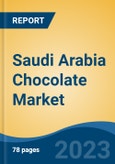Speak directly to the analyst to clarify any post sales queries you may have.
10% Free customizationThis report comes with 10% free customization, enabling you to add data that meets your specific business needs.
The expanding footprint of international brands and the rise of modern retail and e-commerce platforms have made a broader range of chocolate products more readily accessible to consumers. Additionally, there is growing interest in healthier chocolate alternatives, including sugar-free, gluten-free, and organic varieties, which align with shifting consumer preferences towards wellness-oriented indulgence. Together, these dynamics are creating a vibrant and evolving chocolate market landscape in the Kingdom.
Key Market Drivers
Rising Disposable Incomes and Affluent Young Population
Rising disposable incomes and a growing base of young, affluent consumers are among the most significant drivers of Saudi Arabia’s chocolate market. As of 2024, average monthly disposable income for Saudi households reached approximately USD 4814.88, with youth under the age of 25 comprising over half the population. This demographic is increasingly drawn to premium and artisanal chocolates, valuing distinct flavors, ethical sourcing, and high-quality ingredients. Exposure to global trends and willingness to spend on luxury confections have contributed to the rising popularity of niche chocolate segments, including handcrafted and limited-edition products. These consumers are also more inclined to purchase chocolate as a lifestyle product, contributing to the category’s steady annual growth, especially in the premium segment.Key Market Challenges
High Import Dependence for Premium Chocolate Products
A primary challenge in the Saudi chocolate market is the high reliance on imports for premium and specialty chocolate products. While local production is expanding, the market still depends heavily on international brands to meet demand for high-end offerings. This dependence exposes the industry to external risks such as supply chain disruptions, import cost volatility, and currency exchange rate fluctuations. Importing high-quality ingredients like fine cocoa or specialty additives adds to operational costs, leading to higher retail prices and potentially limited affordability for a wider audience. Strengthening local production capacity and enhancing domestic sourcing strategies are crucial to mitigating these risks and achieving long-term market resilience.Key Market Trends
Demand for Healthier Chocolate Option
The trend toward healthier chocolate alternatives is gaining momentum in Saudi Arabia, driven by increased health awareness among consumers. Dark chocolate, with its higher cocoa content and antioxidant benefits, is gaining traction, particularly among health-conscious individuals. Sugar-free, low-sugar, and gluten-free variants are becoming more widely available, often using natural sweeteners like stevia and erythritol. Moreover, there is rising interest in chocolates enriched with functional ingredients such as nuts, berries, matcha, and superfoods, combining indulgence with nutritional benefits. Manufacturers are increasingly innovating to offer chocolates that meet both wellness goals and sensory appeal. This trend reflects a broader global shift toward mindful eating and is expected to shape the development of future product lines in the Saudi chocolate market.Key Players Profiled in this Saudi Arabia Chocolate Market Report
- Mars, Incorporated
- Nestlé Middle East FZE
- Bateel International LLC
- The Hershey Company
- Ferrero International S.A.
- Meiji Holdings Co., Ltd
- Mondelēz International Inc.
- Fujiya Co., Ltd
- Lotte Co., Ltd
- Barry Callebaut
Report Scope:
In this report, the Saudi Arabia Chocolate Market has been segmented into the following categories, in addition to the industry trends which have also been detailed below:Saudi Arabia Chocolate Market, by Product Type:
- White Chocolate
- Milk Chocolate
- Dark Chocolate
Saudi Arabia Chocolate Market, by Category:
- Organic
- Regular
- Gluten-Free
- Sugar-Free
Saudi Arabia Chocolate Market, by Distribution Channel:
- Supermarket & Hypermarket
- Specialty Stores
- Online
- Others
Saudi Arabia Chocolate Market, by Region:
- Eastern
- Western
- Northern & Central
- Southern
Competitive Landscape
Company Profiles: Detailed analysis of the major companies present in the Saudi Arabia Chocolate Market.Available Customizations:
With the given market data, the publisher offers customizations according to a company's specific needs. The following customization options are available for the report.Company Information
- Detailed analysis and profiling of additional market players (up to five).
This product will be delivered within 1-3 business days.
Table of Contents
Companies Mentioned
The leading companies profiled in this Saudi Arabia Chocolate market report include:- Mars, Incorporated
- Nestlé Middle East FZE
- Bateel International LLC
- The Hershey Company
- Ferrero International S.A.
- Meiji Holdings Co., Ltd
- Mondelēz International Inc.,
- Fujiya Co., Ltd
- Lotte Co., Ltd
- Barry Callebaut
Table Information
| Report Attribute | Details |
|---|---|
| No. of Pages | 82 |
| Published | May 2025 |
| Forecast Period | 2024 - 2030 |
| Estimated Market Value ( USD | $ 1.02 Billion |
| Forecasted Market Value ( USD | $ 1.72 Billion |
| Compound Annual Growth Rate | 9.1% |
| Regions Covered | Saudi Arabia |
| No. of Companies Mentioned | 11 |









